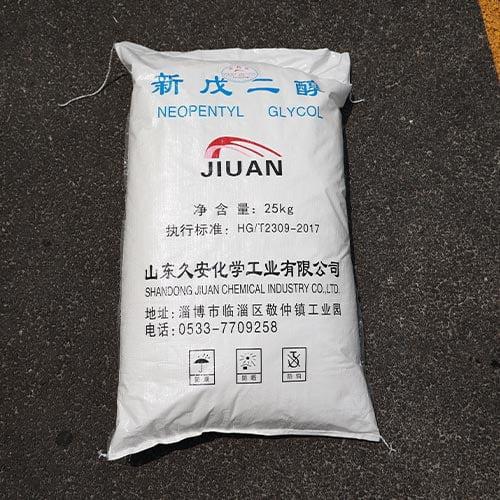Introduction
Neopentyl glycol (NPG) is an organic compound with the formula (CH3)2C(OH)CH2OH. It is a colorless viscous liquid with a characteristic odor. As an industrial chemical, NPG finds wide usage in the production of polyesters, polyurethanes, plasticizers, and other materials.Neopentyl glycol boiling point refers to the temperature at which neopentyl glycol transitions from a liquid to a gas state under standard atmospheric pressure. One important property of NPG that determines its applications is its boiling point. This blog post will explore the significance of NPG’s boiling point in various industrial processes and formulating products.
NPG Boiling Point and Polymer Production

NPG’s moderate boiling point of 250°C makes it well-suited for step-growth polymerization reactions that are commonly employed to synthesize polyesters and polyurethanes. Step-growth polymerizations involve the reaction of monomers containing two or more functional groups such as hydroxyl, carboxyl, or isocyanate groups. The monomers react together in a step-wise manner to form long polymer chains or networks.
The boiling point of the monomers plays a crucial role as the reactions are typically carried out with heat. If the monomers have too low of a boiling point, they will evaporate out of the reaction mixture before fully reacting and polymerizing. On the other hand, if the monomers have too high of a boiling point, higher temperatures will be required which can cause unwanted side reactions.
NPG’s boiling point of 250°C allows it to remain in the liquid phase during polyester and polyurethane syntheses which commonly occur between 150-250°C. Some common polymers produced using NPG include:
| Polymer | Usage |
|---|---|
| Polyethylene terephthalate (PET) | Plastic bottles, food packaging |
| Polybutylene terephthalate (PBT) | Electrical components, appliances |
| Polyurethanes | Foams, coatings, adhesives |
The moderate volatility of NPG ensures high monomer conversion without requiring excessive temperatures that could lead to discoloration or degradation of the polymers.
NPG Boiling Point and Plasticizer Applications
Besides polymer production, NPG also finds wide application as a plasticizer due to its favorable boiling point. Plasticizers are additives that increase the flexibility and workability of materials like plastics, concrete, or clay. They function by dispersing uniformly between the polymer chains or particles and preventing them from packing together tightly.
Commonly used plasticizers have boiling points between 200-300°C so that they do not evaporate from the material over time. NPG’s boiling point of 250°C makes it a suitable plasticizer for applications requiring heat resistance like wire and cable coatings that may experience temperatures of 100-200°C during processing and use. Some other advantages of using NPG as a plasticizer include:
- Low volatility – low volatility translates to reduced material loss and improved efficiency in manufacturing processes. Whether incorporated into coatings, adhesives, or plastics, neopentyl glycol maintains its presence within the product, offering consistent functionality and protection against degradation.
- Thermal stability – Neopentyl glycol maintains its plasticizing efficacy even under elevated temperatures. This unique characteristic ensures that its plasticizing effects remain consistent and reliable, making it an ideal choice for applications requiring resilience to high heat conditions. Whether in polymer matrices or other materials, neopentyl glycol’s enduring plasticizing performance offers long-term stability and functionality.
- Compatibility – Neopentyl glycol exhibits excellent compatibility with a diverse range of polymers, ensuring seamless blending without the risk of phase separation. This remarkable property enables neopentyl glycol to integrate smoothly into polymer matrices, enhancing material homogeneity and performance across various applications. Whether in coatings, adhesives, or plastics, neopentyl glycol’s compatibility fosters superior product quality and consistency.
- Low toxicity – the low toxicity of neopentyl glycol aligns with evolving regulatory standards and consumer preferences for safer and eco-friendly materials. Its use as a plasticizer not only enhances product performance but also reflects a commitment to sustainability and social responsibility.
Its favorable boiling point allows NPG plasticizers to provide long-lasting flexibility and durability in high-temperature environments. Areas where NPG plasticizers see widespread adoption include automotive components, wire insulation, PVC pipes and fittings, flooring materials.
Neopentyl Glycol Boiling Point: Definition and Measurement

Definition: The boiling point of neopentyl glycol refers to the temperature at which it transitions from a liquid to a gas state under standard atmospheric pressure. This temperature is a fundamental characteristic of the compound and is typically measured in degrees Celsius or Fahrenheit.
Measurement: Measuring the boiling point of neopentyl glycol is essential for ensuring its quality and suitability for specific applications. This is typically done using laboratory equipment such as a distillation apparatus or a boiling point apparatus. The process involves heating the neopentyl glycol sample gradually while monitoring the temperature until it reaches the point at which vaporization occurs consistently.
Accurate measurement of the boiling point is crucial as it provides valuable information about the purity and consistency of the neopentyl glycol sample. Any deviations from the expected boiling point range may indicate impurities or variations in composition, which can impact its performance in industrial processes.
Conclusion: Neopentyl glycol boiling point
In essence, the boiling point of neopentyl glycol (NPG) at 250°C presents distinct advantages in industrial settings compared to other diols. Its optimal volatility allows it to serve as a proficient monomer in the synthesis of polyesters and polyurethanes via step-growth polymerization techniques, typically conducted within the range of 150-250°C. This moderate boiling point facilitates controlled reactions, ensuring the formation of high-quality polymers with desired characteristics.
Furthermore, NPG’s specific boiling point renders it an ideal choice as a plasticizer in applications demanding heat resistance up to 200°C. Its ability to withstand elevated temperatures while maintaining stability makes it invaluable in industries requiring durable and resilient materials. Whether incorporated into polymer matrices or utilized as a standalone additive, neopentyl glycol enhances the thermal properties of the final product, contributing to its longevity and performance.
Overall, the favorable attributes derived from its boiling point have propelled the widespread adoption of neopentyl glycol across various sectors. From polymer synthesis to plasticizing formulations and beyond, NPG’s versatility and reliability continue to underpin its extensive utilization in chemical processes worldwide.
FAQs
Q. What temperature does NPG boil at?
A. The normal boiling point of neopentyl glycol is 250°C or 482°F.
Q. How does the boiling point compare to other diols?
A. NPG has a higher boiling point than ethylene glycol (197°C) and propylene glycol (188°C). It has a lower boiling point than 1,4-butanediol (230°C).
Q. Why is a moderate boiling point beneficial?
A. A moderate boiling point allows NPG to remain in the liquid phase during polymerization and processing without requiring excessively high temperatures that could cause degradation.
Q. What applications does the boiling point make it suitable for?
A. A boiling point of 250°C makes NPG ideally suited for polyester/polyurethane production and can be used as a plasticizer at high temperatures.



